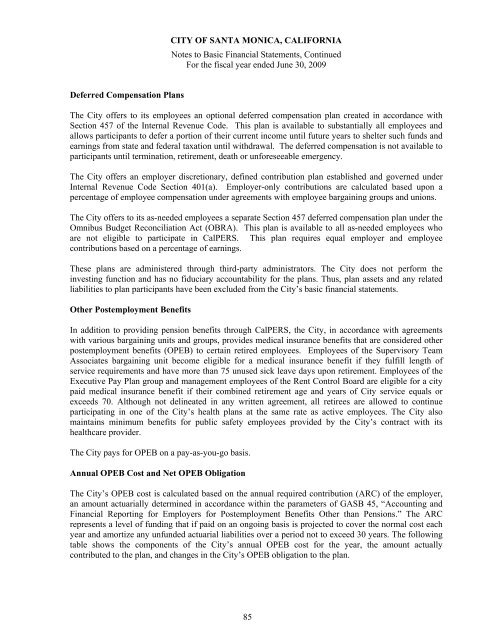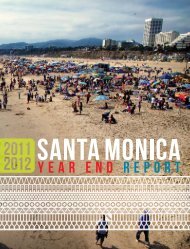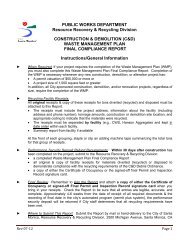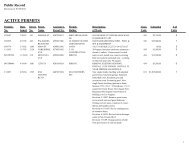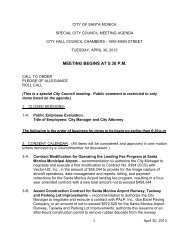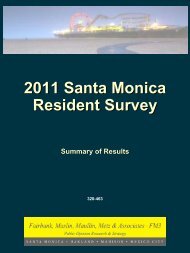Comprehensive Annual Financial Report - City of Santa Monica
Comprehensive Annual Financial Report - City of Santa Monica
Comprehensive Annual Financial Report - City of Santa Monica
You also want an ePaper? Increase the reach of your titles
YUMPU automatically turns print PDFs into web optimized ePapers that Google loves.
CITY OF SANTA MONICA, CALIFORNIA<br />
Notes to Basic <strong>Financial</strong> Statements, Continued<br />
For the fiscal year ended June 30, 2009<br />
Deferred Compensation Plans<br />
The <strong>City</strong> <strong>of</strong>fers to its employees an optional deferred compensation plan created in accordance with<br />
Section 457 <strong>of</strong> the Internal Revenue Code. This plan is available to substantially all employees and<br />
allows participants to defer a portion <strong>of</strong> their current income until future years to shelter such funds and<br />
earnings from state and federal taxation until withdrawal. The deferred compensation is not available to<br />
participants until termination, retirement, death or unforeseeable emergency.<br />
The <strong>City</strong> <strong>of</strong>fers an employer discretionary, defined contribution plan established and governed under<br />
Internal Revenue Code Section 401(a). Employer-only contributions are calculated based upon a<br />
percentage <strong>of</strong> employee compensation under agreements with employee bargaining groups and unions.<br />
The <strong>City</strong> <strong>of</strong>fers to its as-needed employees a separate Section 457 deferred compensation plan under the<br />
Omnibus Budget Reconciliation Act (OBRA). This plan is available to all as-needed employees who<br />
are not eligible to participate in CalPERS. This plan requires equal employer and employee<br />
contributions based on a percentage <strong>of</strong> earnings.<br />
These plans are administered through third-party administrators. The <strong>City</strong> does not perform the<br />
investing function and has no fiduciary accountability for the plans. Thus, plan assets and any related<br />
liabilities to plan participants have been excluded from the <strong>City</strong>’s basic financial statements.<br />
Other Postemployment Benefits<br />
In addition to providing pension benefits through CalPERS, the <strong>City</strong>, in accordance with agreements<br />
with various bargaining units and groups, provides medical insurance benefits that are considered other<br />
postemployment benefits (OPEB) to certain retired employees. Employees <strong>of</strong> the Supervisory Team<br />
Associates bargaining unit become eligible for a medical insurance benefit if they fulfill length <strong>of</strong><br />
service requirements and have more than 75 unused sick leave days upon retirement. Employees <strong>of</strong> the<br />
Executive Pay Plan group and management employees <strong>of</strong> the Rent Control Board are eligible for a city<br />
paid medical insurance benefit if their combined retirement age and years <strong>of</strong> <strong>City</strong> service equals or<br />
exceeds 70. Although not delineated in any written agreement, all retirees are allowed to continue<br />
participating in one <strong>of</strong> the <strong>City</strong>’s health plans at the same rate as active employees. The <strong>City</strong> also<br />
maintains minimum benefits for public safety employees provided by the <strong>City</strong>’s contract with its<br />
healthcare provider.<br />
The <strong>City</strong> pays for OPEB on a pay-as-you-go basis.<br />
<strong>Annual</strong> OPEB Cost and Net OPEB Obligation<br />
The <strong>City</strong>’s OPEB cost is calculated based on the annual required contribution (ARC) <strong>of</strong> the employer,<br />
an amount actuarially determined in accordance within the parameters <strong>of</strong> GASB 45, “Accounting and<br />
<strong>Financial</strong> <strong>Report</strong>ing for Employers for Postemployment Benefits Other than Pensions.” The ARC<br />
represents a level <strong>of</strong> funding that if paid on an ongoing basis is projected to cover the normal cost each<br />
year and amortize any unfunded actuarial liabilities over a period not to exceed 30 years. The following<br />
table shows the components <strong>of</strong> the <strong>City</strong>’s annual OPEB cost for the year, the amount actually<br />
contributed to the plan, and changes in the <strong>City</strong>’s OPEB obligation to the plan.<br />
85


